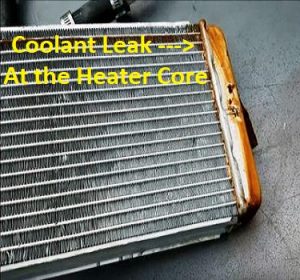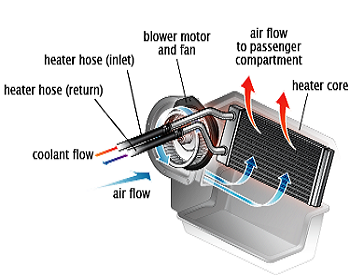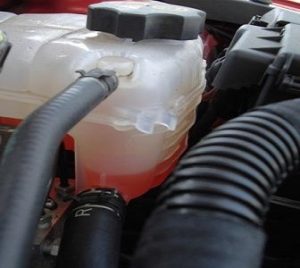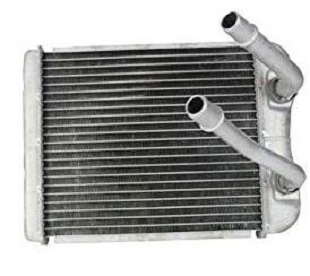
Coolant Leak from Heater Core
In the old days common car heater problems often required replacement of the heater core. This stemmed from the type of antifreeze circulating through the cooling system and the small heat exchanger. The old-fashioned green ethylene glycol engine coolant required frequent maintenance. On automobiles from the 70s and the 80s, manufacturers recommended a coolant flush every 30,000 miles. When car owners neglected to change this fluid it turned acidic and started to eat away at the thin passageways that make up the heater core.
However, on modern automobiles, we use extended life antifreeze that provides a longer life cycle. Even when owners go past the 100,000 mile guideline for maintenance the corrosive side effects become less harmful to the passageways found in both the radiator and the heater core. With that said, it’s still possible to run into a situation where the heater core needs replacing. Nevertheless, when the automobile fails to provide the level of heat expected, mechanics often find the malfunction in the control systems of the car heating system.
Here we’ll cover some brief history about where the various heating systems found in automobiles today came from. In addition, we’ll talk about the main player that uses super-heated engine antifreeze to warm the inside of the car or truck. We’ll also review the three most common symptoms of a failed heater core. Finally, we’ll dig into some common car heater problems that motorists are running into on automobiles that have been built in the last decade.
The Car Heater a Brief History

Heater Core Diagram
During the roaring 20s coach builder’s and car companies decided to focus their attention on providing more comfort for the driver and the passengers. They started enclosing the interior cabin to keep the elements out. Automotive engineers quickly realized they could take this a step further by heating the inside. The solution to the problem became a heat exchanger device that worked just like the radiator used to cool the engine.
The first thing they had to do was divert hot antifreeze through the miniaturized radiator installed in the passenger compartment. Therefore, engine coolant heated from combustion flows from the engine block through rubber hoses attaching to the inlet side of the heater core. The outlet side, then returns this bypassed coolant back into the main system.
The amount of coolant flowing through the heater core determines how hot it gets inside the car. Manufacturers control this with a valve operated from the heater and air conditioning control panel. Car makers use a variable speed blower motor to circulate air around the heater core. Then they push the heated air into the passenger compartment. If you noticed we have just introduced you to several components that can easily cause car heater problems. If the blower motor malfunctions the heated air never reaches the passengers. When coolant doesn’t flow properly through the heater core then cold air is discharged from the system. Let’s tackle these two malfunctions in the next sections.
Diagnosing Car Heater Problems

Coolant Reservoir and Hoses
When drivers seek assistance from a professional mechanic for their car heater problems the technician checks one thing first. They verify the level of antifreeze in the cooling system. This is called a logical path of diagnosis. As we described above, without the proper amount of engine coolant flowing through the heater core the car will not make heat for the passengers.
In fact, a low cooling system is the number one reason that automobiles will experience problems with the car heater. Things like leaking radiator hoses and water pumps can deplete the level of antifreeze to the point where it starves the heater core. After the mechanic verifies that the cooling system is full and the heater core actually gets hot, then they can move on to check the secondary parts of the system that direct airflow around the heat exchanger.
The next logical step in diagnosis becomes to check the control system. It’s the HVAC control panel that moves a manual cable or electric motors that run the blend door. The heater and air conditioning blend door controls how much air flows past the heater core. Mechanics will locate the door and then operate the temperature control all the way from the cold side to the hot. This way they can inspect the movement of the temperature door. This provides insight on whether the motors, cables and ultimately the control panel are doing their job.
What Happens When the Heater Core goes Bad

Automotive Heater Core
Drivers and technicians can both use their nose to detect the first sign of a problem developing. Warm engine coolant leaking inside the vehicle has an unmistakable subtle, but sweet aroma. In fact, it’s easier to detect when it’s trapped inside the automobile than when it’s leaking inside the engine compartment. There are two other conditions that indicate a heater core leak. The most obvious sign is when the passenger side carpet becomes wet with antifreeze.
However, if engine coolant drips down on the interior side of the firewall, it finds its way underneath the carpet. Since automotive carpets have rubberized backing and sound deadening insulation, it can leak for a while before you actually feel wetness on the top side with your hand. When professional mechanics suspect a heater core leak, they’ll peel back the passenger side carpet and look for a puddle of antifreeze collecting on the floor boards.
Finally, another sure sign of a heater core leak is a problem with the inside of the windshield and the efficiency of the defroster operation. The interior fan motor will spray coolant vapor on the inside surface of the windshield as it pushes air through the leaking heater core. This creates a vision problem that doesn’t clean up easily with glass cleaner. The defroster and defogging capability of the air-conditioning system becomes greatly diminished in this scenario. The system relies on dry air to defrost and remove the fog. If you have a car heater problem and a foggy windshield, that won’t clear when using the defroster a leaking heater core becomes a likely suspect.
The post Diagnose and Repair Car Heater Problems appeared first on YouFixCars.com.
Diagnose and Repair Car Heater Problems posted first on https://jacobslowpriceautoglass.blogspot.com
No comments:
Post a Comment